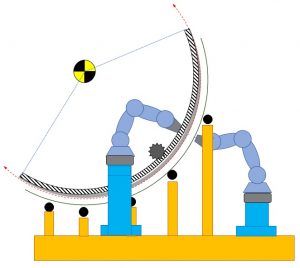One of the most important challenges for the next aircraft assembly lines is the increase of the level of automation to improve quality standards, production rates and flexibility.
Drilling, fastener insertion, riveting, sealing, coating and painting applications, in addition to material handling, are the most recurrent operations in aircraft assembly lines. The majority of these operations are performed by machines and big robots, i.e., high-cost rigid solutions, but still a high number of the drilling and riveting operations are performed by the operators. The LABOR project will contribute to advance the state-of-the-art in the automated assembly allowing the adoption of lean and self-adaptive robotic technologies, that combines:
- small/medium size robots: to provide higher capability of adaptation and easy integration in shop floor already existing facilities;
- adaptive processing tools: to perform in an automatic and adaptive way the different processing tasks;
- advanced vision systems: to reference the robots and check the quality of the work performed;
- distributed intelligence: to build a more flexible solution.
